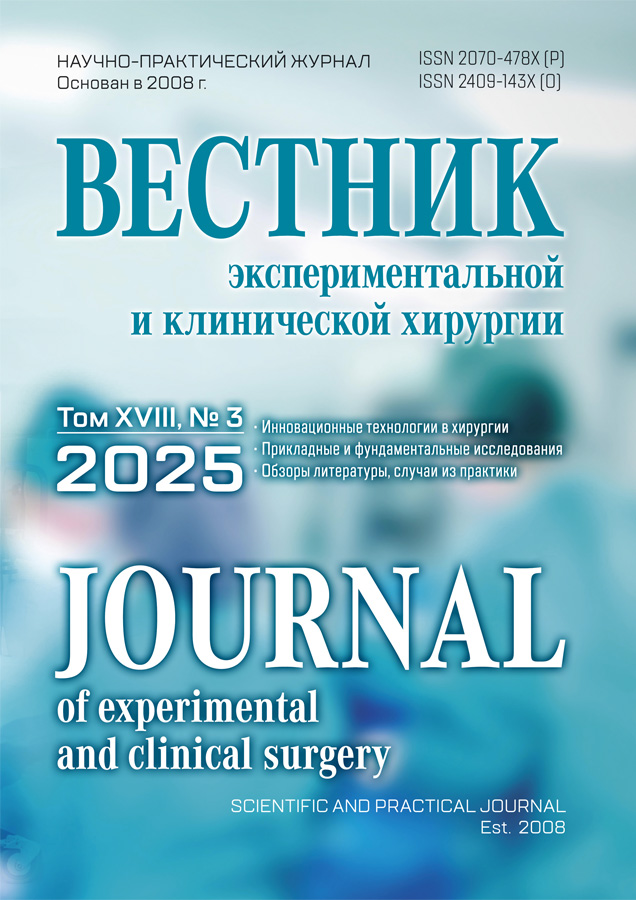Undifferentiated connective tissue dysplasia as a risk factor for recurrence of postoperative ventral hernia
- Authors: Gurin S.N.1,2, Midiber K.Y.3,4, Mudarisov R.R.2, Yurasov A.V.1,5
-
Affiliations:
- Petrovsky National Research Centre of Surgery
- Moscow City Clinical Hospital N52
- Avtsyn Research Institute of Human Morphology of Petrovsky National Research Centre of Surgery
- Patrice Lumumba Peoples’ Friendship University of Russia
- Lomonosov Moscow State University
- Issue: Vol 18, No 3 (2025)
- Pages: 188-194
- Section: Original articles
- URL: https://vestnik-surgery.com/journal/article/view/1878
- DOI: https://doi.org/10.18499/2070-478X-2025-18-3-188-194
- ID: 1878
Cite item
Abstract
Backgraund. Despite the development of surgical techniques, the recurrence rate of postoperative hernias (PH) remains high. There is increasing evidence in the literature on the role of connective tissue pathology in the development and recurrence of postoperative ventral hernias
Aim. Establish the relationship between the severity of connective tissue dysplasia (CTD) and the results of plastic PH also identify the correspondence between the phenotypic and morphological signs of CTD in patients with PH.
Materials and methods. The study was conducted on the basis of the "Petrovsky National Research Centre of Surgery" and GBUZ "GCB No. 52 DZM" from 2018 to 2024. The main group consisted of 91 patients with postoperative hernia, the control group consisted of 10 patients who underwent surgery with a history of laparotomy, but without the formation of PH. The groups are identical in age, gender ratio, and comorbidity. 25 plastic surgeries were performed with local tissues and 66 with the use of a mesh prosthesis, morphometric studies of aponeurosis for the ratio of type 1 and type 3 collagen were performed in 50 patients. All patients were assessed for the severity of external signs of connective tissue dysplasia using the Luzgina-Shkurupiya method. The reliability of differences between the groups in the number of hernia recurrences was assessed for each group by the coefficient of statistically significant differences calculated using the Pearson's χ2 criterion. The ratio of collagen types was calculated by analyzing micrographs based on a color histogram in Adobe Photoshop with the calculation of the average number of pixels of different colors for the entire preparation: type 1 collagen - red spectrum, type 3 – green. Quantitative indicators were evaluated for compliance with the normal distribution using the Shapiro-Wilk criterion. Quantitative indicators, the sample distribution of which corresponded to the normal, were described using arithmetic averages (M) and standard deviations (SD). The boundaries of the 95% confidence interval (95% CI) were indicated as a measure of representativeness for the mean values. A comparison of three or more groups by a quantitative indicator, the distribution of which in each group corresponded to the normal one, was performed using a one-factor analysis of variance, aposteriori comparisons were carried out using the Tukey criterion (assuming equality of variances). The differences were considered statistically significant at p < 0.05.
Results. When comparing patients with PH and dysplasia of mild and severe severity, statistically significant differences in the number of relapses were revealed, including with mesh plastics (P<0.05). Statistically significant (P<0.05) differences in the number of pixels were found, reflecting the ratio of type 1 and type 3 collagen, in the direction of an increase in type 3 collagen with an increase in the severity of connective tissue dysplasia
Conclusions. It was found that the probability of PH recurrence significantly increases with increasing severity of CTD, therefore, assessment of the severity of CTD is an important element in the treatment of patients with PH. This makes it possible to prevent the recurrence of PH by choosing the most appropriate surgical technique. Diagnosis of CTD is carried out by phenotypic and morphological methods. The study proved that there is a direct relationship between the phenotypic manifestations of CTD and its morphological features. Therefore, both methods can be adequately applied to assess the severity of CTD.
Keywords
Full Text
About the authors
Sergey Nikolaevich Gurin
Petrovsky National Research Centre of Surgery; Moscow City Clinical Hospital N52
Author for correspondence.
Email: sergey.gurin.97@mail.ru
post-graduate student, Jr. Researcher, Surgeon of the surgical department No.1
Russian Federation, Moscow; MoscowKonstantin Yurievich Midiber
Avtsyn Research Institute of Human Morphology of Petrovsky National Research Centre of Surgery; Patrice Lumumba Peoples’ Friendship University of Russia
Email: midiber@yandex.ru
Ph.D., Head of the Group of Pathomorphological and Immunohistochemical Studies, Reference Center for Infectious and Viral Oncopathology, Assistant, Department of Pathological Anatomy, Medical Institute
Russian Federation, Moscow; MoscowRinat Rifkatovich Mudarisov
Moscow City Clinical Hospital N52
Email: docmr@rambler.ru
Ph.D., chief surgeon
Russian Federation, MoscowAnatolii Vladimirovich Yurasov
Petrovsky National Research Centre of Surgery; Lomonosov Moscow State University
Email: ayurasov@mail.ru
M.D., Chief Researcher of the Department of Thoracoabdominal Surgery and Oncology
Russian Federation, Moscow; MoscowReferences
- Belokonev VI, Gogia BSh, Gorsky VA, Ermakov NA, Zhdanovsky VV, Ivanov IS, Ilchenko FN, Kabanov EN, Kovaleva ZV, Lebedev NN, Matveev NL, Rezkin DV, Olovyanny VE, Parshikov VV, Presnov KS, Protasov AV, Pushkin SYu, Rybachkov VV, Rutenburg GM, Samartsev VA, Struchkova AD, Kharitonov SV, Cherepanin AI, Chernykh AV, Shestakov AL, Ettinger AP, Yurasov AV. Klinicheskie rekomendatsii «Posleoperatsionnaya ventral'naya gryzha (Vzroslye)». TsENTRMAG. 2024; 62. (in Russ.)
- Harrison B, Sanniec K, Janis JE. Collagenopathies Implications for Abdominal Wall Reconstruction: A Systematic Review. Plastic and Reconstructive Surgery Global Open. 2016; 4: 10: e10. doi: 10.1097/GOX.0000000000001036
- Kravtsov YuA, Pakholyuk YuP, Mikhailyuk EV. The role of connective tissue dysplasia in the recurrence of hernias of the anterior abdominal wall. Sovremennye problemy nauki i obrazovaniya.2020; 1: 100. (in Russ.)
- Kubyshkin VA, Galliamov EA, Agapov MA, Kakotkin VV, Davlyatov MR. significance of the structure and metabolism of the extracellular matrix in the pathogenesis of abdominal hernias.Review. Khirurgicheskaya praktika. 2020; 1: 24-32. https://doi.org/10.38181/2223-2427-2020-1-24-32 (in Russ.)
- Rodrigues M, Kosaric N, Bonham CA, Gurtner GC. Wound healing: A cellular perspective. Physiological Reviews. 2019; 1: 99: 665-706. doi.org/10.1152/physrev.00067.2017
- Radu P, Bratucu M, Garofil D. The Role of Collagen Metabolism in the Formation and Relapse of Incisional Hernia. Chirurgia (Bucur). 2015; 110: 3: 224-230.
- Onlain-katalog genov cheloveka i geneticheskikh zabolevanii. Dostupno po: https://omim.org/ Ssylka aktivna na 21.08.2025.
- Beighton P, De Paepe A, Danks D. International nosology of heritable disorders of connective tissue. Am. J. Med. Gen. 1988; 29: 581–594.
- Luzgina N.G., Shkurupii V.A. Patent 2455940 № 2010152890/14 RF. Sposob diagnostiki stepeni tyazhesti sindroma nedifferentsirovannoi displazii soedinitel'noi tkani. Dostupno po: https://rusneb.ru/catalog/000224_000128_0002455940_20120720_C1_RU/ Ssylka aktivna na 20.08.2025.
- Liu J, Xu MY, Wu J. Picrosirius-Polarization Method for Collagen Fiber Detection in Tendons: A Mini-Review. Orthop Surg. 2021; 13: 3: 701-707. doi: 10.1111/os.12627
- Coelho PGB, Souza MV, Conceição LG, Viloria MIV, Bedoya SAO. Evaluation of dermal collagen stained with picrosirius red and examined under polarized light microscopy. An Bras Dermatol. 2018; 93: 3: 415-418. doi: 10.1590/abd1806-4841.20187544
- Junqueira LC, Bignolas G, Brentani RR. Picrosirius staining plus polarization microscopy, a specific method for collagen detection in tissue sections. Histochem J. 1979; 11: 447–455. https://doi.org/10.1007/BF01002772
- Rittiе L. Method for Picrosirius red‐polarization detection of collagen fibers in tissue sections. Methods Mol Biol. 2017; 1627: 395–407. https://doi.org/10.1007/978-1-4939-7113-8_26
- Lazarenko VA, Ivanov IS, Tsukanov AV, Ivanov AV, Goryainova GN, Obedkov EG. Architectonics of collagen fibers in the skin and aponeurosis in patients with and without ventral hernias. Kurskii nauchno-prakticheskii vestnik «Chelovek i ego zdorov'e». 2014; 2: 41-45. (in Russ.)
- Fachinelli A, Trindade MRM. Qualitative and quantitative evaluation of total and types I and III collagens in patients with ventral hernias. Langenbecks Arch Surg. 2007; 392: 459–464. https://doi.org/10.1007/s00423-006-0086-9
- Peeters E, De HG, Junge K, Klinge U, Miserez M. Skin as marker for collagen type I/III ratio in abdominal wall fascia. Hernia. 2014; 18: 519–525. https://doi.org/10.1007/s10029-013-1128-1
- Dzheng Sh, Dobrovolsky SR. Connective tissue dysplasia as a reason of recurrent inguinal hernia. Khirurgiya. Zhurnal im. N.I. Pirogova. 2014; 9: 61-63. (in Russ.)
- Fedoseev AV, Chekushin AA. Undifferentiated connective tissue dysplasia how one of possible mechanism of external hernias formation. Rossiiskii mediko-biologicheskii vestnik im. akademika I.P. Pavlova. 2010; 18: 3: 125-130. https://doi.org/ 10.17816/PAVLOVJ20103125-130 (in Russ.)
- Bereschenko VV, Lyzikov AN, Shebushev NG, Chernobayev MI. The visual sings of connective tissue dysplasia in patients with inguinal and femoral hernia. Problemy zdorov'ya i ekologii.2014; 4: 51-54. https://doi.org/10.51523/2708-6011.2014-11-4-9. (in Russ.)
- Raileanu RI, Botezatu AA, Podolinny GI, Paskalov YuS, Marshalyuk AV. Hernia disease as a manifestation of systemic connective tissue dysplasia. Sovremennye problemy nauki i obrazovaniya. 2018; 3: 75-84. URL: https://science-education.ru/ru/article/view?id=27715 https://doi.org/10.17513/spno.27715 (in Russ.)
Supplementary files














